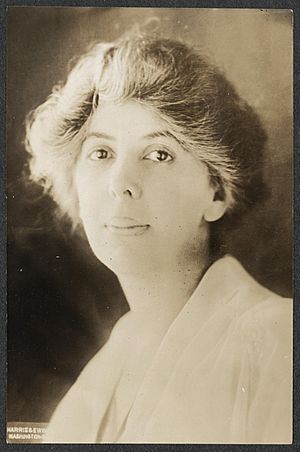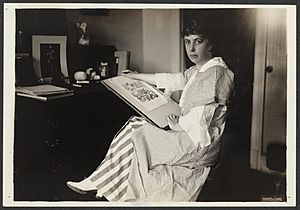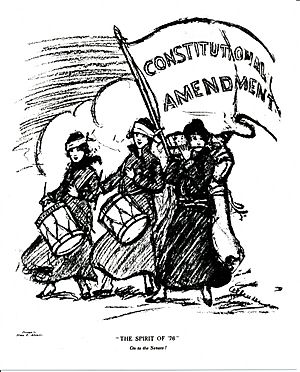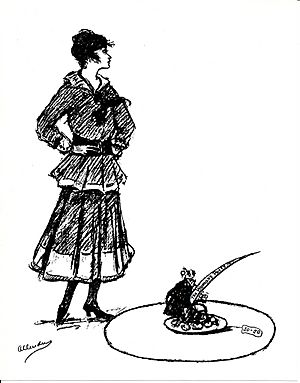Nina E. Allender facts for kids
Quick facts for kids
Nina Evans Allender
|
|
|---|---|

Nina E. Allender, about 1915
|
|
| Born |
Nina Evans
December 25, 1873 |
| Died | April 2, 1957 (aged 83) |
| Nationality | American |
| Education |
|
| Known for | Political cartoonist |
| Spouse(s) | Charles H. Allender (1893–1905, divorce) |
Nina Evans Allender (born December 25, 1873 – died April 2, 1957) was an American artist, cartoonist, and a strong supporter of women's rights. She studied art in the United States and Europe with famous teachers like William Merritt Chase and Robert Henri. Nina Allender was an organizer, speaker, and campaigner for women's right to vote. She became the "official cartoonist" for the National Woman's Party's newspapers, creating popular drawings known as the "Allender Girl."
Contents
Nina Allender's Life
Early Years and Family
Nina Evans was born on Christmas Day, December 25, 1873, in Auburn, Kansas. Her father, David Evans, was a teacher and school superintendent. Her mother, Eva Moore, was also a teacher. The family moved to Washington, D.C., where Eva Evans worked for the government. She was one of the first women to be hired by the federal government. Nina's father also worked for the government and was a writer.
Marriage and Later Life
In 1893, when she was 19, Nina Evans married Charles H. Allender. Their marriage ended in 1905.
After studying art in Europe, Nina Allender worked for the government in Washington, D.C. She lived in Washington in 1916 and also had an art studio in New York City. In 1942, Nina moved to Chicago, Illinois, and lived there for more than ten years. In 1955, she moved to Plainfield, New Jersey, to live near her niece. She passed away in Plainfield on April 2, 1957.
Art and Women's Rights
Art Education and Style
Nina Allender took art classes at the Corcoran Museum of Art. She then studied with Robert Henri and William Merritt Chase at the Pennsylvania Academy of the Fine Arts from 1903 to 1907. She even went on painting trips to Italy with Robert Henri. Nina considered William Merritt Chase and Robert Henri to be her most important teachers. In London, she also studied with Frank Brangwyn. Her early art often featured landscapes, like "excellent little snow pictures."
Fighting for Women's Right to Vote
When she was 38, Nina Allender became very active in the National American Woman Suffrage Association (NAWSA). This group worked to get women the right to vote. In 1912, she traveled to Ohio to help campaign for women's suffrage, which means the right to vote. She enjoyed talking to people door-to-door and joining demonstrations.
Nina helped plan a big parade for women's suffrage in Washington, D.C., in 1912. She was in charge of "outdoor meetings" and "posters, post cards and colors." Soon after, she became president of the local Woman Suffrage Association in Washington, D.C. She often spoke at meetings. In 1913, she was president of the Stanton Suffrage Club, which discussed how voting rights affected businesswomen. She even spoke alongside Jeannette Rankin, who later became a congresswoman.
In 1913, Nina and her mother, Eva, joined the Congressional Union of NAWSA. This group later became the National Woman's Party, led by Alice Paul. Nina and Eva promised to donate money each month and volunteer their time to the organization.
Nina also helped organize a parade in Delaware in 1914. She was known as one of the best "street orators" (public speakers) for the suffrage campaign. In 1916, she was a delegate at the first convention of the National Woman's Party. She also went to Wyoming to ask for support for a federal law that would give women the right to vote. When the National Woman's Party started protesting outside the White House, Nina joined them. In 1917, she designed special valentines for President Woodrow Wilson and lawmakers, asking them to support women's voting rights.
The National Woman's Party Cartoonist
Newspapers were very important for the women's rights movement. In 1913, the Congressional Union started its own newspaper called The Suffragist. Nina Allender became the main artist for this newspaper, drawing political cartoons. She had a special talent for it and became The Suffragist's "official cartoonist." Her first political cartoon was published in June 1914.
Nina Allender created 287 political cartoons about women's suffrage. She became famous for her "Allender girl" drawings. These drawings showed a new kind of suffragist: a young, strong, and modern American woman. These images helped change how people saw women who were fighting for the right to vote. Instead of old stereotypes, Nina showed stylish, attractive, and dedicated young women. Her cartoons also featured Congressmen, Uncle Sam, and symbols for the suffrage amendment to promote the National Woman's Party's goals.
Nina Allender also designed the "Jailed for Freedom" pin. This pin was given to women who were arrested for protesting and picketing for their rights, starting in July 1917. It honored women like Amelia Himes Walker, who was imprisoned for two months.
In September 1920, the cover of The Suffragist featured Nina's cartoon called Victory. This cartoon celebrated women finally getting the right to vote. The Suffragist was published weekly until 1921. Later, in 1923, a new newspaper called Equal Rights started, and Nina continued to draw cartoons for it. She kept working for equal rights even after women won the right to vote. She retired in 1946 due to poor health.
Art Organizations
Nina Allender was a member of several art groups:
- Arts Club of Washington, D.C. (she was a founding member)
- Art Students League of Washington
- Beaux Arts Club
- Society of Washington Artists
- Washington Watercolor Club
Art Exhibitions
Nina Allender's artwork was shown in many places, including:
- Arts Club of Washington
- Cosmos Club of Washington
- National Academy of Design
- Pennsylvania Academy of the Fine Arts
- The Society of Washington Artists
- Library of Congress
- Sewall–Belmont House and Museum
Legacy and Impact
After women won the right to vote, Nina Allender continued to be active in the National Woman's Party, working for gender equality for another twenty years. Her original drawings were first kept at the Library of Congress. Later, they were moved to the Belmont–Paul Women's Equality National Monument (which used to be the headquarters for the National Woman's Party). Some of her drawings have been reprinted in books.
In 1995, to celebrate 75 years since the Nineteenth Amendment gave women the right to vote, the National Museum of Women in the Arts held an exhibition called "Artful Advocacy: Cartoons of the Woman Suffrage Movement." Nina Allender's work was featured alongside other artists like Lou Rogers and Blanche Ames. Her cartoons helped change public opinion and played a big part in the fight for women's voting rights.
Images for kids
See also
 In Spanish: Nina E. Allender para niños
In Spanish: Nina E. Allender para niños









